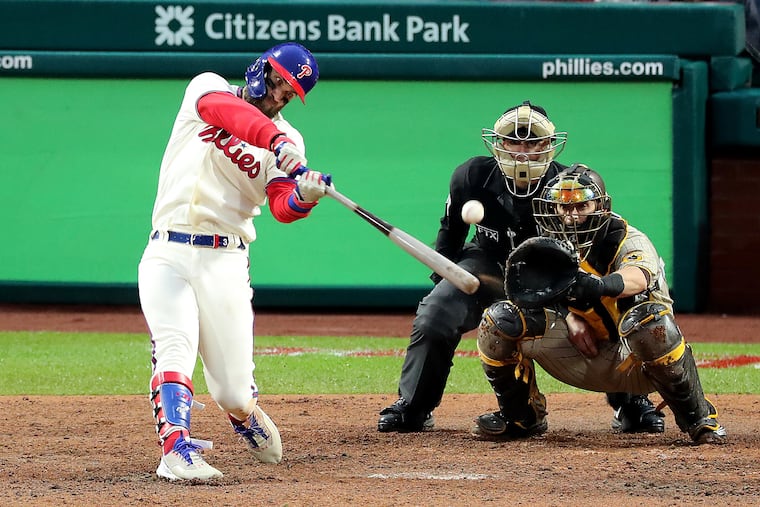For the Phillies’ wild-card series, it’s going to feel like June in South Philly
The winds should favor the hitters Wednesday and Thursday night. But you may be surprised at what can affect the flight of he ball.

It may be shy of “hittin’ season” conditions, but the weather for the wild-card series at Citizens Bank Park should be a grand slam, with June-like temperatures, light winds, unblemished skies, and a 100% chance of about 43,000 bodies per game generating considerable heat and noise.
“There’s basically no chance of rain,” said Alex Staarmann, a meteorologist with the National Weather Service in Mount Holly. In fact the agency was listing a 0% chance for Games 1 and 2, Tuesday and Wednesday, rising to all of 3% for the “if-necessary” Game 3 Thursday.
It won’t be quite Miami weather when the Florida Marlins are in town, but highs will be in the 80s Tuesday and Wednesday and near 80 Thursday — eight to 10 degrees above normal, or about average for the first week in June in Philadelphia — with mild evenings. Tuesday’s forecast calls for temperature readings in the mid-70s at game time.
While the weather should be perfect for the spectators, it also should give some comfort to the hitters. That’s based on the perspectives of two scientists who have delved into how the atmosphere affects the flight of the baseball.
But baseball can match the atmosphere for unpredictability, with so many variables in play, perhaps even the baseballs themselves.
Winds
Alan Nathan, a physicist who chaired the Major League Baseball committee that investigated the home run binge of a few years back, notes that a wind change of just 5 mph can make a 15- to 20-foot difference in the flight of the ball.
Paul Dorian, a meteorologist and lifelong Phillies fan, sees winds as the most important factor in the home run forecasts that he posts daily, which assesses how well the ball would be carrying on a given day. (For $5 a month, premium customers can get 48-hour outlooks.)
With rain-repelling high pressure over the region, said the weather service’s Staarmann, the winds will be light, if not negligible Tuesday. But the next two nights they will be blowing out toward right field, about seven mph Wednesday, and 10 mph Thursday.
Dorian’s outlooks use a 1-to-10 scale, with 10 being the most favorable for homers, and 1, the least. He said the forecasts can be useful for the over-under bettors (he isn’t one), since the scale has “a strong correlation” with runs scored per game. High-homer games usually are higher scoring.
The wind forecasts Wednesday and Thursday would argue for the higher end of the scale, but his wild-card outlooks this week are likely to wind up in the middle ranges.
The temperatures
While Dorian considers barometric pressure and moisture levels in the air, his second most important variable after the wind is temperature.
Alan Nathan, a University of Illinois professor emeritus, has calculated that every degree Fahrenheit on average means about a 4-inch difference in the flight of the ball.
And although the warmth won’t measure up to the level of heat evoked by former Phillies Manager Charlie Manuel’s concept of ”hittin’ season,” but this isn’t exactly a cold wave.
Last year, the high on Oct. 4, 54 degrees, set a record for the date for the lowest daily maximum temperature.
A 20-degree change would make about a 6-foot difference in how the ball carries, using Nathan’s calcuations.
Wild cards and stitches
Ultimately, says Nathan, the “drag coefficient,” or air resistance, and how the ball interacts with the molecules in the atmosphere is a key to how far a ball is going to travel. Dorian uses drag estimates in his forecasts.
The molecules impede the progress of the ball significantly: Nathan and an associate estimated that a ball traveling 400 feet in the air would sail about 700 feet in a vacuum.
In the study that he led of baseball’s 2015-17 home run surge, Nathan and his team found that it was driven by subtle changes in drag coefficients that couldn’t be readily explained. He discounted conspiracy theories, including a popular one that the balls were juiced because fans love homers.
The home run numbers returned to earth in 2021 and 2022. In terms of launch angle and velocities, “the balls were hit more optimally,” he said, but for some reason, the drag increased.
His own hypothesis is that it all had to do with unscripted changes in how the balls were stitched. They are sewn by hand, and imperceptible differences are all but inevitable.
They affected, and still affect, the drag, he reasoned. He’s also convinced this is nothing new.
“There are things in the manufacturing of the baseball that simply can’t be controlled all that well,” he said last week. “My guess is it’s always been that way. We’re noticing it now because we have all this information at our fingertips.”
Drag coefficients, winds, barometric pressure, and the waning moon notwithstanding, the biggest factors will be the pitchers and catchers.
On Saturday, Sept. 23, the winds were howling in from right to left field, it was chilly enough for a fire, but Bryce Harper somehow managed to hit a 450-foot home to right center.
“That was through the teeth of the wind,” said Dorian. “That was quite amazing.”